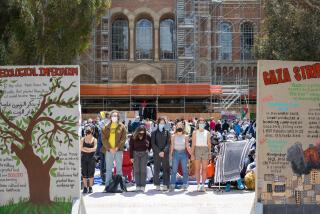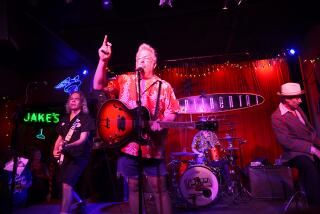The odd couple
- Share via
NIXON’S trip to China in 1972 was an iconic event. A brilliant diplomatic stroke, the trip melted decades of deep freeze between two of the world’s great powers and realigned the geopolitical triangle with the Soviet Union. It was a savvy political move too, clinching Nixon’s image at home as a foreign policy virtuoso and helping ensure his reelection later that year despite his inability to solve the quagmire in Vietnam. Nixon’s trip to China was one of those rare political coups that seemed utterly impossible beforehand and unavoidably logical afterward.
Yet more than anything, it was terrific theater. To see Nixon, that beady-eyed communist-hater, toasting the Mao suits in the Great Hall of the People, climbing the Great Wall and meeting Mao Tse-tung himself in the Communist Party’s inner sanctum -- it was mesmerizing. No one cared that the visit was largely symbolic and light on content. It was great symbolism at play.
In “Nixon and Mao: The Week That Changed the World,” accomplished historian Margaret MacMillan draws together the colorful strands of the drama, with all its inherent chanciness and tension. MacMillan is strong on diplomacy but weak on Chinese politics; yet she’s a fine writer whose illuminating account shows why it’s no wonder that the trip inspired an entire Western opera and a permanent place in our lexicon, as in “It was a Nixon-goes-to-China moment.” What is a wonder is that it has taken until now for a general history to be written about this diplomatic milestone.
The scene was unforgettable: China, though still embroiled in a violent paroxysm called the Cultural Revolution, appeared serene and enchanting to American viewers. A gaggle of U.S. reporters followed Nixon to scenic spots and his meetingw with China’s happy workers and smiling schoolchildren. The cast of characters was top-notch: Nixon, Mao, Henry Kissinger and Premier Chou En-lai, each with his own individual brand of psychosis, paranoia and dastardly political skill. The intermingling of these four, in a complex diplomatic mating dance that could easily have gone wrong, is a historian’s dream.
MacMillan’s previous book, “Paris 1919,” is a history of the intricate negotiations involved in the peace treaty negotiations after World War I. She crafted a richly satisfying narrative that conveyed the far-reaching effects of those negotiations while giving a full flavor of its primary players, including Woodrow Wilson, David Lloyd George and Georges Clemenceau.
In “Nixon and Mao,” MacMillan opens with the flight to Beijing. Nixon was anxious; he knew he was taking a big risk. If the trip failed, he could be blamed for making a colossal blunder. The draft diplomatic agreement between the two countries was still far from complete, and there was no guarantee it would be signed by the end of the trip. There was no commitment by the Chinese that Nixon would even meet Mao, who was said to be having difficulty getting out of bed or leaving his chamber.
Nixon had studied hard, as he always did, knowing that true diplomatic success would require a subtle understanding of the politics of the leaders he was meeting. He practiced using chopsticks so he wouldn’t look silly at banquets. His advance team worked hard as well, to get the best camera angles for the U.S. media. MacMillan also shows us how Nixon was concerned with petty problems, like keeping his secretary of state, William Rogers, out of major meetings with Mao and Chou. Nixon worked better with Kissinger, who shared his love of stealth.
In fact, MacMillan shows us that Nixon and Kissinger insisted on secrecy at every step of planning for the visit. On Kissinger’s previous trip to Beijing to lay the groundwork for the rapprochement, Mao and Chou -- no slouches in clandestine matters -- were baffled by American demands to keep all quiet. Nixon and Kissinger claimed that the right wing in Washington would sabotage their plans. Relying on interviews, research and newly available documents, MacMillan persuasively challenges this view: Nixon and Kissinger, she suggests, were just addicted to secrecy.
Mao was much like Nixon in his paranoia, his inability to make friends and his brilliant interpretation of history and politics. For Mao, deciding to open relations with the United States marked a sharp turn from his fanatical leftism and his ultra-isolationist foreign policy. MacMillan stumbles here. She sees Mao as a patriot, concerned with the good of his nation, when what he really cared about was the good of Mao. For decades, historians have said he missed few opportunities to destroy his country.
Mao drove foreign policy to meet the imperatives of his own domestic politics; in 1972, that meant restraining leftists in his midst. As chairman of the Communist Party, Mao was like a mob boss, appearing to be totally in charge but perpetually at work to keep his captains off-balance, lest one challenge him. It was precisely that fear that generated Mao’s feud with his No. 2, Lin Biao, whose mysterious death in a plane crash offers a haunting backdrop to the time period when Nixon’s trip was being planned.
Vietnam became a fascinating sideshow to the trip; leaders in Hanoi turned apoplectic at the sight of their main enemy shaking hands with their supposed patron in the north. In the months afterward, Mao was impatient with Hanoi and tossed its leaders a simple suggestion: Sign a peace treaty, regroup until after most Americans have left and then roll in. “That is, in effect, what happened,” MacMillan observes.
It was Taiwan that presented the toughest impediment to a joint agreement on Nixon’s visit. Kissinger labored to come up with language that would satisfy China’s insistence that American support eventual reunification and still allow for a U.S. demand for peaceful change. It was treacherous diplomatic territory, and only on the final day of the visit did both sides agree to what became known as the Shanghai Communique.
In 1972, few could imagine that Taiwan would today be a thriving democracy, that China would enjoy one of the biggest economic expansions in world history, that the Soviet threat would be a distant memory, that Vietnam would be welcoming American investors. Yet MacMillan’s book shows how those dynamics, in varying ways and degrees, all grew from seeds planted the day Nixon’s foot landed on Chinese soil. *
More to Read
The biggest entertainment stories
Get our big stories about Hollywood, film, television, music, arts, culture and more right in your inbox as soon as they publish.
You may occasionally receive promotional content from the Los Angeles Times.










